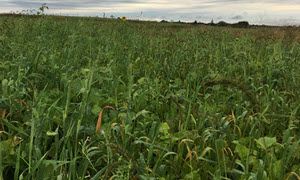Prevented Planting (PP) Cover Crop Relief
 Cover crops provide multiple benefits to current and future cropping systems, such as preventing soil and wind erosion, improving the soil’s physical and biological properties, and suppressing weeds. These benefits become especially important when soil is left bare after a prevented planting situation. Widespread weather events over recent years has resulted in significant prevented planting claims under the Federal crop insurance program. Given these extreme weather patterns and the need to provide producers ample opportunities to protect the nation’s natural resources, the Risk Management Agency has re-evaluated the interaction between cover crops and the Federal crop insurance programs.
Cover crops provide multiple benefits to current and future cropping systems, such as preventing soil and wind erosion, improving the soil’s physical and biological properties, and suppressing weeds. These benefits become especially important when soil is left bare after a prevented planting situation. Widespread weather events over recent years has resulted in significant prevented planting claims under the Federal crop insurance program. Given these extreme weather patterns and the need to provide producers ample opportunities to protect the nation’s natural resources, the Risk Management Agency has re-evaluated the interaction between cover crops and the Federal crop insurance programs.
Currently, procedures for cover crops and prevented planting provide November 1 as the reference point for when a cover crop may be hayed, grazed, or cut for silage, haylage, or baleage, and the producer may still receive a full prevented planting payment. If the cover crop is hayed, grazed, or cut for silage, haylage, or baleage before November 1, or harvested for grain or seed at any time, the cover crop is considered a second crop and the producer’s prevented planting payment is reduced by 65%.
Per Manger’s Bulletin MGR-21-004, for the 2021 and succeeding crop years, the November 1 date in the FCIC procedures, as it relates to haying, grazing, or cutting for silage, haylage, or baleage, has been rescinded. A cover crop planted on acreage claimed as prevented from being planted can be hayed, grazed, or cut for silage, haylage, or baleage at any time without reduction to the prevented planting payment, provided the insured meets all other policy provision requirements. However, a cover crop harvested for grain or seed at any time will result in a prevented planting payment reduction in accordance with the CCIP Basic Provisions. Please click to review the Manger’s Bulletin MGR-21-004 in full.
Are you reading the Underwriting: Strength in the Field eNewsletter? Click here for the next article: Hurricane Insurance Protection – Wind Index (HIP-WI) Changes
